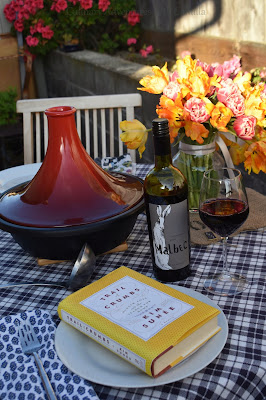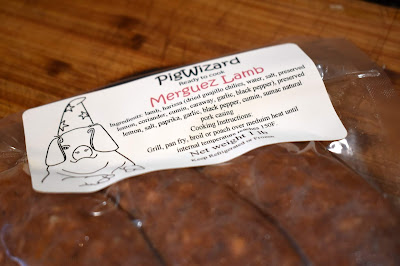When I put a call out for book recommendations to the hive mind - for books either written by French authors or set in France - my friend Joselyn suggested Trail of Crumbs: Hunger, Love, and the Search for Home by Kim Sunée.* She actually hadn't read it, but I'm always game to read foodie memoirs.
On the Page
I'll be honest: It's tough for me to read memoirs from people whose decisions just make me want to scream or shake some sense into them. This was one of those. Kim Sunée was abandoned in a marketplace in South Korea when she was three years old. Then she was adopted by an American couple who raised her in New Orleans. And she ended up living in Europe for a decade, with a stint in Sweden but most of the time in France. While her descriptions of food and travel were beautifully written, her relationships with men - particularly her lengthy affair with Olivier Baussan, the founder of L'Occitane en Provence - were maddening in their self-destructive natures. And, at nearly 400 pages, this memoir was far too long!
Sunée does evoke a sense of place with her prose, though. So, I'll share a few of my favorites...
"Although memories are distorted, there are true sensations one doesn't forget, like fear and hunger, deep rumblings echoing in a cavernous heart and belly. I still see rat-colored streets, try to focus on market vendors, the swift movements of street cooks; I am forever trying to decipher a familiar face. I want warmth and a mouthful of hot fermented cabbage, a bowl of plain rice" (pg. 2).
"Everything in my new world seems shiny and palatable, especially my new favorite color. The bright red on my tennis shoes suddenly makes me run real fast. Orange red is the color of fire under the pots and peppers of all shapes and sizes. Some become a liquid called Tabasco from Avery Island, others get ground into a dark magical powder with the beautiful name of cayenne" (pp. 8-9).
"We get to Cancale just in time for lunch. Cold raw oysters from the bay - delicious, although milkier this time of year - and Riesling, a bitter green salad, Camembert de Normandie and tarte à la fraise for dessert. Driving up the coast in a tipsy breeze, we arrive in the walled-in city of Saint-Malo. There's still enough sunlight to highlight the fortress. The air's salty and nourishing, the coastline rugged. There are signs everywhere advertising moules frites and buckwheat crêpes filled with andouille or onions and cream. We stop for a sweet Breton pastry and a glass of hard farmhouse cider before checking into the Hotel Chateaubriand" (pg. 278).
On the Plate
Sunée includes many recipes that I cannot wait to try. There are so many that the book includes a recipe index! Her Anchovies in Jansson's Frestelse, Chocolate Cake with Chestnut Mascarpone Cream, Gratin de Salsify, and Tipsy Melons with Prosciutto will certainly make it to my table soon. But, for this post, I decided to do a riff on her chicken tagine with cinnamon and dates. "The whole apartment smells of cardamom and earthy cinnamon, something sweet. 'Une tagine de poulet aux dattes,' she announces passing around cumin-infused carrot slices and large marinated olives" (pg. 153).
Whenever I see the word 'Merguez' in a recipe or on a menu, my little foodie heart always skips a beat. I love those distinctive North African spices and am lucky to have a favorite local purveyor who makes Merguez lamb sausages. Thankfully, PigWizard is still open during these trying times of being sheltered in place. I placed the order online and ran over to pick this up, along with some yeast and his signature spice rub which I didn't use for this recipe, but will use soon. I also had organic oranges, onions, celery, and carrots from a local farm delivery. Cooking during this COVID-19 pandemic is a little challenging at times, but I try to keep it interesting while being safe at home.
I used her recipe, that's included in the book, as a starting point. I swapped out her raisins for dried apricots because that's what I had in my cupboard. Also, I added celery to the pot. And I make my tagine on the stove instead of in the oven...that darn pot doesn't fit in my oven!
About the pot: a tagine. A tajine or tagine is a Maghrebi dish named after the
earthenware pot in which it is cooked. So, it refers to both the cooking vessel
and the resulting food; it is also called a maraq/marqa in North Africa and the
Middle East.
I used her recipe, that's included in the book, as a starting point. I swapped out her raisins for dried apricots because that's what I had in my cupboard. Also, I added celery to the pot. And I make my tagine on the stove instead of in the oven...that darn pot doesn't fit in my oven!
Mentions of the tagine date back to Harun al-Rashid who was
a ruler of the Early Muslim conquests and it appears in the 9th century
collection of stories One Thousand and One Nights. At the same
time, it was noted during the Islamic reign of the Abbasid Empire that
stretched from the Middle East/Asia to North Africa and Andalusia.
The dish was used by nomadic Bedouin people of the Arabian
Peninsula, who added dried fruits such as dates, apricots and plums to it.
Tagine is traditionally cooked over hot charcoal with the shape of the lid
acting as a self-basting tool. The circular base is flat with low sides and the
cover is a large cone-shape that sits on the base during cooking. The cover is
designed to collect all condensation and re-direct to back to the bottom.
If you don't have a tagine, don't despair. This recipe works just as well in a Dutch oven or other heavy lidded pot.
Ingredients serves 6
- 1 T olive oil
- 2 links Merguez lamb sausage or other spicy sausage
- 4 bone-in, skin-on chicken thighs
- freshly ground salt
- freshly ground pepper
- 1 large onion, peeled and diced (approximately 1-1/2 C)
- 2 to 3 carrots, sliced into coins (approximately 1 C)
- 2 to 3 ribs celery, sliced (approximately 1 C)
- 3 garlic cloves, peeled and smashed
- 1" knob fresh ginger, peeled and grated
- 1 t ground cinnamon
- 1/2 t ground cumin
- 1/2 t paprika (I used smoked paprika)
- zest from 1 organic orange
- 2 C chicken stock or water
- 1 to 2 T white wine or water
- 1/2 C freshly squeezed orange juice
- 1/2 C dried apricots
- 12 to 15 dates, pitted
- 2 organic oranges, peeled and sliced
- fresh chopped cilantro for garnish
- pine nuts for garnish, optional (I didn't have any)
Procedure
Sprinkle your chicken with salt and pepper on both sides. Heat olive oil in the bottom of your tagine or Dutch oven. Cook the sausages until firm, approximately 3 minutes on all sides. Remove them from the pot and slice in half or thirds. Add the chicken to the pot, skin-side down and brown for 5 minutes. Flip them over and brown for another 5 minutes. Remove them from the pot.
Add the onions, carrots, and celery to the pot. Stir to coat with the oil and fat from the sausages and chicken. Cook for 3 to 4 minutes.
Nestle the chicken and sausage into the vegetables and add in the garlic and ginger. Sprinkle with the cinnamon, cumin, paprika, and orange zest. Pour in the chicken stock, wine, and orange juice. Bring to a boil. Then cover and reduce to a simmer. Cook for 1 hour.
After an hour, tuck the pitted dates and apricots into the liquid. Cover and return to the stove for another 30 minutes.
After the 90 minutes of cooking, add orange slices to the top and scatter with cilantro. Bring the heat up to reduce the sauce slightly. Make sure to stir so that nothing is burning on the bottom. Once it's at your desired thickness, let stand for 10 minutes before serving.
If desired, serve with hot buttered couscous and harissa paste or chutney. I served it with a Moroccan-spiced rice.
*This blog currently has a partnership with Amazon.com in their affiliate program, which gives me a small percentage of sales if you buy a product through a link on my blog. It doesn't cost you anything more. If you are uncomfortable with this, feel free to go directly to Amazon.com and search for the item of your choice.
Click to see what everyone else read in May 2020: here.












You definitely convinced me to skip that book, one of so many tales of the American living in France and discovering so much that's been known by the French forever. I have made a search for native French books about food: they are fewer, but definitely interesting and more revealing than the wide-eyed American genre.
ReplyDeleteYour tagine sounds wonderful. The French have indeed assimilated North African flavors in a delightful way.
be well... mae at maefood.blogspot.com
I've been enjoying your virtual trips to France by book and food.
ReplyDeleteHow nice it is when you can spend time with your family, your hobby, your hobbies. You are probably wondering when I work and where did I get so much time? Everything is very simple. Good money can be made by giving a little time thanks to the f1 us grand prix.
ReplyDelete